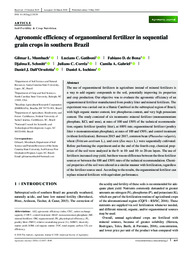Agronomic efficiency of organomineral fertilizer in sequential grain crops in southern Brazil.
Agronomic efficiency of organomineral fertilizer in sequential grain crops in southern Brazil.
Author(s): MUMBACH, G. L.; GATIBONI, L. C.; DE BONA, F. D.; SCHMITT, D. E.; CORREA, J. C.; GABRIEL, C. A.; DALL'ORSOLETTA, D. J.; IOCHIMS, D. A.
Summary: Abstract The use of organomineral fertilizers in agriculture instead of mineral fertilizers is a way to add organic compounds to the soil, potentially improving its properties and crop production. Our objective was to evaluate the agronomic efficiency of an organomineral fertilizer manufactured from poultry litter and mineral fertilizers. The experiment was carried out in a Humic Cambisol in the subtropical region of Brazil, with high organic matter content, low phosphorus content, and very high potassium content. The study consisted of six treatments: mineral fertilizer (monoammonium phosphate, KCl, and urea), at rates of 100 and 150% of the technical recommendation; organic fertilizer (poultry litter), at 100% rate; organomineral fertilizer (poultry litter + monoammonium phosphate), at rates of 100 and 150%; and control treatment (without fertilization). Between 2015 and 2017, common bean (Phaseolus vulgaris), wheat (Triticum aestivum L.), and corn (Zea mays L.) were sequentially cultivated. Before performing the experiment and at the end of the fourth crop, chemical properties of the soil were analyzed in the 0- to 10- and 10- to 20-cm layers. The use of fertilizers increased crop yield, but there was no difference between the three fertilizer sources or between the 100 and 150% rates of the technical recommendation. Chemical properties of the soil were altered in a similar manner with fertilization, regardless of the fertilizer source used. According to the results, the organomineral fertilizer can replace mineral fertilizers with equivalent performance.
Publication year: 2020
Types of publication: Journal article
Unit: Embrapa Wheat
Observation
Some of Embrapa's publications are published as ePub files. To read them, use or download one of the following free software options to your computer or mobile device. Android: Google Play Books; IOS: iBooks; Windows and Linux: Calibre.
Access other publications
Access the Agricultural Research Database (BDPA) to consult Embrapa's full library collection and records.
Visit Embrapa Bookstore to purchase books and other publications sold by Embrapa.

